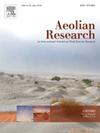East Asian winter monsoon during the late quaternary shifted the provenance of red earth in mid-subtropical China
IF 3.4
3区 地球科学
Q2 GEOGRAPHY, PHYSICAL
引用次数: 0
Abstract
The loess-like Quaternary red clay (QRC) covers extensive areas in South China, making its genesis and provenance essential for interpreting this unique paleoclimate archive in subtropical regions. However, it remains unclear whether the loess-like QRC originates from local fluvial deposits, the Chinese Loess Plateau, or a mixture of both. This study investigates the provenance of the loess-like QRC in mid-subtropical China, focusing on the interaction between local and distant dust sources. To achieve this, we applied geochemical methods, including grain size analysis, mineralogy, provenance indicators, and quantitative analysis, to two loess-like QRC sections (JL and LHH). Our findings indicate that the silt fraction is more effective for provenance discrimination, necessitating caution when interpreting bulk samples. Notably, the LHH section shows a shift from a predominance of local dust at the bottom to a significantly higher contribution from distant dust at the top. This trend suggests that since around 0.44 Ma, the intensification of the East Asian Winter Monsoon (EAWM) has facilitated enhanced dust transport from Central Asia, shifting the provenance of red earth in mid-subtropical China and reinforcing the mixed-source origin of the loess-like QRC. Additionally, variations in heavy mineral content indicate weak silicate weathering and/or pedogenesis in the YBS and VYS layers, which also suggesting a dry and cold climate since 0.44 Ma. This research provides valuable insights into the sediment dynamics and climatic factors shaping the provenance of the loess-like QRC in subtropical regions.
晚第四纪东亚冬季风改变了中亚热带红土的物源
黄土样第四纪红粘土(QRC)在华南地区分布广泛,其成因和物源对解释这一亚热带地区独特的古气候档案至关重要。然而,目前尚不清楚这种类似黄土的QRC是来自当地的河流沉积,还是中国黄土高原,还是两者的混合。本文研究了中国中亚热带黄土样QRC的物源,重点研究了局地和远地沙尘源之间的相互作用。为此,我们应用地球化学方法,包括粒度分析、矿物学、物源指标和定量分析,对两个类黄土QRC剖面(JL和LHH)进行了研究。我们的研究结果表明,泥沙分数对物源判别更有效,在解释大量样品时需要谨慎。值得注意的是,LHH剖面显示了从底部本地尘埃的优势到顶部远处尘埃的显著更高贡献的转变。这一趋势表明,自0.44 Ma左右以来,东亚冬季风(EAWM)的增强促进了中亚沙尘的增加,改变了中国中亚热带红土的来源,加强了黄土状红土的混合来源。此外,重矿物含量的变化表明YBS和VYS层的硅酸盐风化作用和/或成土作用较弱,也表明0.44 Ma以来的气候干燥寒冷。本研究对亚热带类黄土QRC物源形成的泥沙动力学和气候因素提供了有价值的认识。
本文章由计算机程序翻译,如有差异,请以英文原文为准。
求助全文
约1分钟内获得全文
求助全文
来源期刊

Aeolian Research
GEOGRAPHY, PHYSICAL-
CiteScore
7.10
自引率
6.10%
发文量
43
审稿时长
>12 weeks
期刊介绍:
The scope of Aeolian Research includes the following topics:
• Fundamental Aeolian processes, including sand and dust entrainment, transport and deposition of sediment
• Modeling and field studies of Aeolian processes
• Instrumentation/measurement in the field and lab
• Practical applications including environmental impacts and erosion control
• Aeolian landforms, geomorphology and paleoenvironments
• Dust-atmosphere/cloud interactions.
 求助内容:
求助内容: 应助结果提醒方式:
应助结果提醒方式:


